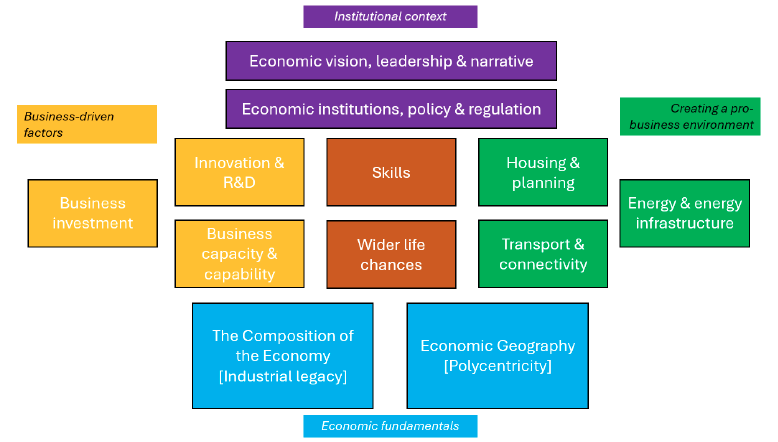Section 4: Sub-System Analysis
There will be no silver bullet solution to achieving our vision of inclusive growth and higher living standards across all parts of the region. Instead, we will need to grip key challenges and opportunities across the twelve interconnected ‘sub-systems’ that make up the West Midlands economic system.
Below, we summarise the overarching hypotheses that describes the essence of the key challenge and/or opportunity facing the region, visualised on the following page. Each is unpacked and further explored in detail in the remainder of section 4.
- Economic Geography and Polycentricity. The West Midlands may sufer lower productivity on account of its morphological polycentricity relative to London or Manchester–we have less ‘agglomeration’. But if it can enhance the functional integration between and harness the complementary roles of its cities and boroughs, recognising the signifcance of Birmingham, it may have a ‘goldilocks’ combination of scale, location and spread for quality of life and inclusive growth.
- Industrial Composition. The industrial composition of the West Midlands economy is a source of strength rather than a weakness.
- Research, Development and Commercialisation. The amount of private sector research and development is a strength of the West Midlands economy, but it is constrained by the low levels of public and higher education sector R&D.
- Business Leadership, Management and Technology Adoption. Business leadership and management in the West Midlands is a distinctive regional challenge. Linked to this, technology adoption by businesses is a high priority for regional productivity and future investment.
- Investment. Private invest demand and public investment into infrastructure is relatively low in the region. Both of these constrain productivity growth in the West Midlands.
- Life Chances. Giving every child and young person better starts in life is the most important action we can take to enable them to live longer, happier, more purposeful, productive and fulflling lives. For working age residents of the West Midlands, far too many reduce their hours or leave the labour market entirely to undertake caring responsibilities, reducing their earnings potential, which afects women in particular. Alongside this, there are well-evidenced racial inequalities in the labour market and economy that afect a signifcant number of West Midlands residents.
- Skills and Participation. The West Midlands has a shortage of higher-level (Level 3 and above) skills, which is forecast to increase over the next decade—and is the most signifcant skills-related constraint to economic growth.
- Housing and Placemaking. The West Midlands' housing system is constraining regional productivity through stifing agglomeration benefts, displacing investment, reducing household resilience and increasing deprivation. Addressing these challenges will require the region to signifcantly increase house building across diferent tenure types, densify housing in urban centres and around the region's transport hubs, helping to create the conditions for vibrant high streets.
- Transport. Because of our polycentricity, the West Midlands needs to better connect our boroughs to our cities and our cities to each other and improve public transport connectivity into Birmingham specifcally, helping to reduce the region’s car dependency.
- Energy. Securing a grid connection and high energy prices are challenging in many parts of the country, but they are a particular challenge in the West Midlands because of the disproportionate number of manufacturing businesses running high temperature processes across dispersed sites. The West Midlands has the ability to mitigate these challenges and reduce its energy consumption by pursuing smart energy systems.
- Institutions. Notwithstanding recent progress, limited devolution to the West Midlands holds back our economy. Making the most of devolution—and efectively delivering a regional economic strategy of the kind proposed in our theory of growth—will require stronger horizontal and vertical links between public institutions and regional partners. Perceptions and Narrative.
- Perceptions of the West Midlands represent a barrier to attracting people and investment. This is not a narrow branding issue and recent successes represent a foundation for improvement.

Figure 5: Summary map of the ‘sub-systems’ that make up the West Midlands economic system
